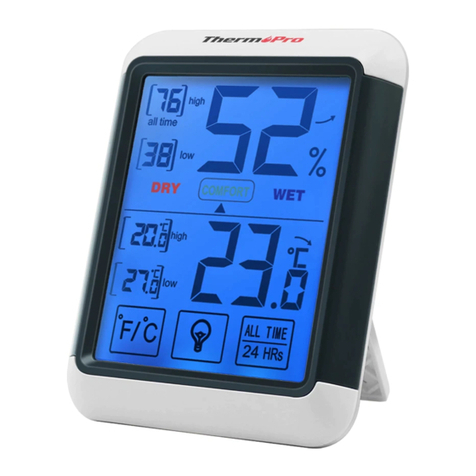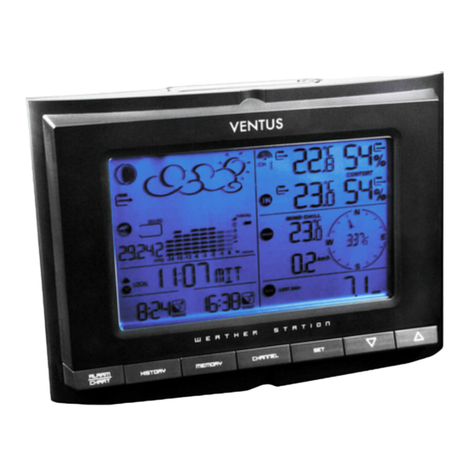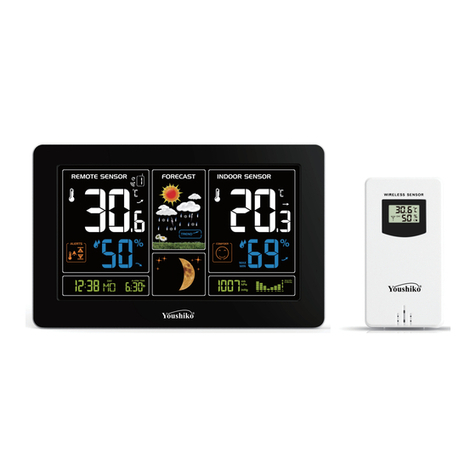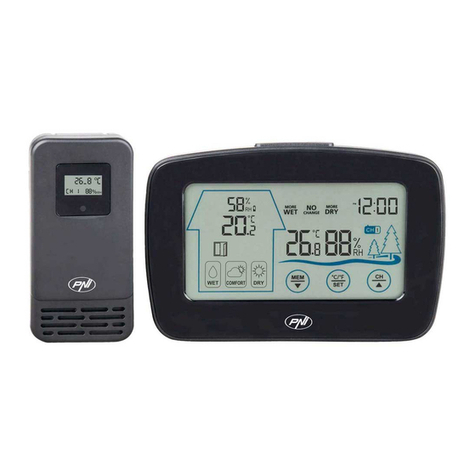SEABELL SH-018 User manual

WIRELESS WEATHER STATION
Instruction manual Model:SH-018
1.Description of parts
A 13
Fig. 1: Receiver
A 1
A 2
A 3
A 4
A 5A 6
A10
A 9
A 7
A 12
WEATHER STATION
B2
B1
B3
B4
Fig. 2
Fig. 3: Transmitter
C 1
C 2
C 4
C 3
-1-
A 15
A 14
A 8
A 11

A1:
A8:
Outdoor temperature
Air pressure
A2:
A9:
Ourdoor humidity maximum and minimum
RCC symbol / week
A3:
A10:
Indoor humidity trend
A4:
A11:
Month/Date
Indoor low power symbol
A5:
A12:
Indoor temperature and humidity display
A6:
A13:
Outdoor temperature trend
Indoor temperature trend
A7:
A14:
Time/alarm
Weather forecast symbols
Fig. 1
Fig. 2
B1: Wall mounting hole
B2: Buttons
B3: Battery cover
B4: Stand (fold out)
Fig. 3
C1: Wall mounting hole
C2: Battery compartment (screwed)
C3: Switch 1-2-3 for channel selection
C4: TX button
2. Before you start using it
• Please make sure to read the instruction manual carefully.
This information will help you to familiarise yourself with your new device, to learn all of its functions
and parts, to find out important details about its first use and how to operate it and to get advice in
the event of a malfunction.
• Following and respecting the instructions in your manual will prevent damage to your instrument and
loss of your statutory rights arising from defects due to incorrect use.
• We shall not be liable for any damage occurring as a result of non following of these instructions.
Likewise,we take no responsibility for any incorrect readings and for any consequences which may
result from them.
• Please take particular note of the safety advice!
• Please keep this instruction manual for future reference.
3.Scope of delivery
• Wireless weather station (Receiver)
• Outdoor transmitter (CH1)
• Instruction manual
4.Specifications
• Measuring range indoors:Temperature -10°C~+60°C(14°F~140°F) Humidity 20%~95%;
• Measuring range outdoors:Temperature -40°C~+70°C(-40°F~158°F) Humidity 20%~95%;
• Accury:Temperature +/-1°C(2°F) between 0°C to 50°C,otherwise +/-2°C(4°F),Humidity +/-5%;
• 3 channels transmitter display on the screen,no need to switch by button.
• Power Consumption:Receiver 2 X 1,5V AAA(not include),Transmitter 2 X 1,5V AAA(not include);
• Air pressure measuring,unit hPa;
• RCC function:DCF or WWVB (select before production);
• Transmission distance: 60m in free field;
• Transmission frequency:433MHZ;
• Transmission time: CH1:50 seconds CH2:53 seconds CH3:56 seconds;
• Low battery index:2.6V;
• Weather forecast:sunny,partly cloudy,cloudy,rainy,stormy;
• Temperature and humidity trend.
• This product is exclusively intended for the field of application described above. It should only be used
as described within these instructions.
•
5. For your safety
• Unauthorized repairs, modifications or changes to the product are prohibited.
-2-
Outdoor low power symbol
Channel number
Ourdoor humidity trend and RF symbol
Indoor humidity maximum and minimum
A15:

Caution!
Risk of injury:
• Keep these instruments and the batteries out of the reach of children.
• Batteries must not be thrown into a fire, short-circuited, taken apart or recharged. Risk of explosion!
• Batteries contain harmful acids. Low batteries should be changed as soon as possible to prevent
damage caused by leaking.
• Never use a combination of old and new batteries together, nor batteries of different types.
• Wear chemical-resistant protective gloves and safety glasses when handling leaking batteries.
Important information on product safety!
• Do not place your device near extreme temperatures, vibrations or shocks.
• Protect it from moisture.
• The outdoor transmitter is protected against splash water, but is not watertight. Choose a shady and
dry position for the outdoor transmitter.
!
!
• Place both instruments on a desk with a distance of approximately 1.5 meter. Avoid getting close to
possible interference sources (Electronic devices and radio installations).
• Remove the protective foil from the display of the receiver.
• Remove the battery cover and insert two new batteries 1,5V AAA,polarity as illustrated,Close the battery
compartment again.
• The device will alert you with a beep and all LCD segments will be displayed for a short moment.
• The default:
TIME:2015-1-1, 0:00; Week langauge:ENG;
ALARM: 7:00, OFF ; Hour system: 24hr;
Temperature unit: °C
6.2 Inserting the batteries in the outdoor transmitter
• Open the screwed battery compartment of the outdoor transmitter.
• The slide switch for channel selection is at position 1 (default).
• Insert two new batteries 1,5 V AAA, polarity as illustrated.
• Close the battery compartment again.
6.1 Inserting the batteries in the receiver
6. Getting started
• The outdoor values of the outdoor transmitter will be transmitted to the receiver. The displays of the
outdoor values are flashing "--.-".
• On the display of the receiver appear the channel number, the outdoor humidity and the outdoor temp-
erature in °C (default).
• If the reception of the outdoor values fails within three minutes, "- -"appears on the display. Check the
batteries of the transmitter and try it again. Check if there is any source of interference.
• You can also start the outdoor transmitter search manually later on (for example when the outdoor
transmitter is lost or the batteries are changed).
• Hold the SEARCH button on the receiver for three seconds,"---"appears on the display.
• Press the TX button in the battery compartment of the outdoor transmitter.
• The device will alert you with a beep and the receiver receives the values from the outdoor transmitter.
• After successful installation close the battery compartment of the outdoor transmitter carefully.
6.2.1 Reception of the outdoor values
6.3 Reception of the DCF frequency signal
• After the reception of the outdoor values, the device will now scan the DCF frequency signal and
the DCF symbol will be flashing on the display.
• To avoid interference, the other buttons will no function during the reception of the radio controlled
clock.
-3-

no symbol - no reception / time is manually set
• When the time code is received successfully after 2-12 minutes, the radio-controlled time and the
DCF symbol are displayed steadily in the display. The other buttons are activated permanently.
• You can start the initialization manually.
• Press and hold the -/RCC button for 3 seconds. The DCF symbol will be flashing.
• Interrupt the reception by pressing the -/RCC button again. The DCF symbol disappears.
• The DCF reception always takes place hourly between 2:00 and 5:00 o'clock in the morning. If the
reception is not successfully received until 5:00 o'clock, the next receive operation is again at 2:00
o'clock in the morning.
There are three different reception symbols:
flashing - reception is active
stays - reception is very good
• If the clock cannot detect the DCF-signal (for example due to disturbances, transmitting distance,
etc.),the time can be set manually. The DCF symbol disappears and the clock will then work as a
normal quartz clock.(see: Manual settings).
NOTE:For WWVB,the area A2(fig.1) display WWVB symbol,the RCC reception same as DCF.
6.3.1 Note for radio-controlled time DCF
The time base for the radio-controlled time is a caesium atomic clock operated by the Physikalisch
Technische Bundesanstalt Braunschweig.It has a time deviation of less than one second in one million
years. The time is coded and transmitted from Mainflingen near Frankfurt via frequency signal DCF-77
(77.5 kHz)and has a transmitting range of approximately 1,500 km.Your radio-controlled clock receives
this signal and converts it to show the precise time. Changeover from summer time or winter time is
automatic. In Daylight Saving Time "DST" is shown on the LCD. The quality of the reception depends
mainly on the geographic location. Normally there should be no reception problems within a 1,500 km
radius around Frankfurt.
Please take note of the following:
• The recommended distance to any interfering sources like computer monitors or TV sets at least
1.5-2 meters.
• Inside ferro-concrete rooms (basements,superstructures),the received signal is naturally weakened.
In extreme cases, please place the unit close to a window to improve the reception.
• During night-time, the atmospheric interference is usually less severe and reception is possible in
most cases.A single daily reception is adequate to keep the accuracy deviation under 1 second.
• During the operation, all successful settings will be confirmed by a brief beep tone.
• The device will automatically quit the setting mode if no button is pressed for a long period of time.
• Press and hold the -/RCC or +/°C/°F button in the setting mode for fast running.
7.1 Manual settings
• Hold the MODE button in normal mode for three seconds, to enter the setting mode.
• The setting sequence is shown as follows: second-hour-minute-year-month-date-week language-
12 or 24 hours system (24H default)-time zone.
• Press the -/RCC or +/°C/°F button to increase or decrease for setting.
• Press and hold the -/RCC or +/°C/°F button for fast running.
• Confirm the setting with the MODE button or no button pressed in 20 seconds.
• The manually set time will be overwritten by the DCF time when the signal is received successfully.
7. Operation
-4-

7.1.1 Setting of the time zone
• In the setting mode you can make the time zone correction (-12/+12).
• The time zone correction is needed for countries where the DCF signal can be received but the time
zone is different from the German time (e.g. +1=one hour later).
7.1.2 Setting of the 12 and 24 hours display
• In the setting mode you can choose between the 12 - and 24 hour system.
• In the 12 HR system AM or PM (after 12 o'clock) appears on the display.
7.2 Setting of the alarm time
• Press the MODE button to enter ALARM mode,ALARM symbol display,and 7:00 am default.
• Hold MODE button for 3 seconds,the hours digit will be flashing.
• Press the -/RCC or +/°C/°F button to adjust the hours.
• Press the MODE button again and you can adjust the minutes with the -/RCC or +/°C/°F button.
• Confirm the setting with the MODE button.
• Press the -/RCC or +/°C/°F button to switch on ALARM,the symbol appear on the display. The
alarm function is activated.
• When the adjusted alarm time is reached, the alarm will ring. The alarm symbol will be flashing.
• Press any button and the alarm will stop.
• If the alarm is not stopped manually, the increasing alarm will automatically turn off after certain
minutes and will be reactivated at the same time.
• The alarm will be interrupted for 2 minutes.
7.1.3 Week display
Language German English Italian French Dutch Spanish Danish
Abbreviation GER ENG ITA FRE DUT SPA DAN
Sunday SON SUN DOM DIM ZON DOM SON
Monday MON MON LUN LUN MAA LUN MAN
Tuesday DIE TUE MAR MAR DIN MAR TIR
Wednesday MIT WED MER MER WOE MIE ONS
Thursday DON THU GIO JEU DON JUE TOR
Friday FRE FRI VEN VEN VRI VIE FRE
Saturday SAM SAT SAB SAM ZAT SAB LOR
• Press and hold +/°C/°F button for switch week or second display.
NOTE:For WWVB time setting,the sequence is shown as follows:
second-hours-minutes-year-month-date-week language-12 or 24 hours system (24H default)-DST
on or off-time zone.
TIME ZONE:PST-MST-CST-EST,the default is CST.
• The weather station has five different weather symbols(sunny,slightly cloudy,cloudy,rainy and stormy).
• The weather forecast relates to a range of 12 hours and indicates only a general weather trend. The
accuracy is about 70 %.
• For example, if the current weather is cloudy and the rain symbol is displayed, it does not mean the
product is faulty because it is not raining. It simply means that the air pressure has dropped and the
weather is expected to get worse but not necessarily rainy. The accuracy is about 70 to 75%.
• The sun symbol also appears at night if there is a starry night.
8. Weather forecast symbols
sunny partly cloudy cloudy rainy stormy
Fig. 4
-5-

• Press the MAX/MIN button in normal mode,MAX appears on the display.
• You can now get the highest values for the indoor and outdoor temperature and humidity since the last
reset.
• Press the MAX/MIN button again,MIN appears on the display.
• You can now get the lowest values for the indoor and outdoor temperature and humidity since the last
reset.
• Press the MAX/MIN button once more, to go back to the present values display.
• The device will automatically quit the MAX/MIN mode if no button is pressed.
• Press and hold the MAX/MIN button for two seconds while the maximum or minimum values are
displayed to clear the recorded readings.
9. Thermometer and hygrometer
9.1 Maximum/Minimum function
Please note that the forecast symbol will become more defined in the course of operation. The forecast
symbol is active right from the start, however, the reliability of the forecasts increases with the amount
of data collected. The sensor must adapt initially to the reference level at the site.
Note:
9.2 Setting of the temperature unit
• In the normal mode you can change between °C (Celsius) or °F (Fahrenheit) as temperature unit.
• Press the +/°C/°F button.
• For having more than one additional outdoor transmitter select with the 1/2/3 switch in the battery
compartment of the outdoor transmitter for each single outdoor transmitter a different channel. The
reception of the new transmitter will be transmitted automatically to the receiver. Press and hold the
SEARCH button on the receiver or restart the receiver according to the manual.
• The outdoor values will be shown on the display of the receiver.
10. Additional outdoor transmitters
9.3 Temperature and humidity trend function
indicates rising temperature readings(temperature gone up more than 2 degrees in an hour)
• Temperature trendIndicators
indicates steady temperature readings
indicates falling temperature readings(temperature gone down more than 2 degrees in an hour)
indicates rising humidity readings(humidity gone up more than 1% in an hour)
• Humidity trendIndicators
indicates steady humidity readings
indicates falling humidity readings(humidity gone down more than 1% in an hour)
• If the measure values above the range,then temperature display "HH.H",humidity display "HH%".
• If the measure values below the range,then temperature display "LL.L",humidity display "LL%".
• With the foldable leg at the back of the receiver, the receiver can be placed onto any flat surface or
wall mounted at the respective location by the hanging holes at the back of the unit. Avoid the vicinity
of any interfering field like computer monitors or TV sets and solid metal objects.
• With the hanging hole at the back of the outdoor transmitter, the transmitter can be wall mounted at
the respective location. Choose a shady and dry position for the outdoor transmitter. (Direct sunshine
falsifies the measurement and continuous humidity strains the electronic components needlessly).
• Check the transmission of the signal from the outdoor transmitter to the receiver (transmission range
of up to 60 m free field). Within ferro-concrete rooms (basements, superstructures), the received
signal is naturally weakened.
• If necessary choose another position for the outdoor transmitter and/or receiver.
11. Positioning and fixing of receiver and the outdoor transmitter
-6-

Ensure that the batteries polarity are correct
Change the batteries
Press and hold the -/RCC button for three seconds and start the initi-
alization manually
Wait for attempted reception during the night
Choose another place for your product
Manual setting of the clock
Check if there is any source of interference
Restart the basic station according to the manual
No outdoor transmitter is installed
Check batteries of external transmitter
Indication "--" (do not use rechargeable batteries!)
Restart the outdoor transmitter and the basic station according to the
Start the outdoor transmitter search manually according to the manual
Choose another place for the outdoor transmitter and/or the receiver
Reduce the distance between the outdoor transmitter and the receiver
Check if there is any source of interference
Change the batteries
Pro Solution
No indication
at the receiver
➜
No DCF reception ➜
➜
➜
➜
➜
➜
No reception of the ➜
outdoor transmitter ➜
for channel 1/2/3 ➜
manual
➜
➜
➜
➜
Incorrect indication
or low power symbol
display
➜
➜
13. Troubleshooting
This product has been manufactured using high-grade materials and components which can be
recycled and reused.
Never dispose of empty batteries and rechargeable batteries in household waste. As a
consumer,you are legally required to take them to your retail store or to an appropriate
collection site depending on national or local regulations in order to protect the environment.
The symbols for the heavy metals contained are: Cd=cadmium, Hg = mercury; Pb=lead
This instrument is labelled in accordance with the EU Waste Electrical and Electronic Equip-
ment.Directive (WEEE).
Please do not dispose of this instrument in household waste. The user is obligated to take
end-of-life devices to a designated collection point for the disposal of electrical and electronic
equipment,in order to ensure environmentally-compatible disposal.
14. Waste disposal
-7-
• Change the batteries of the outdoor transmitter, when the battery symbol appears on the display of the
out door values.
• Change the batteries of the basic station,when the battery symbol appears on the display of the indoor
values.
• Please note: When the batteries are changed, the contact between outdoor transmitter and receiver
must be restored,so always insert new batteries into both devices or start a manual transmitter search.
12.1 Battery replacement
• Clean the devices with a soft damp cloth. Do not use solvents or scouring agents.
• Remove the batteries and pull out the power adapter of the socket, if you do not use the products for
a long period of time.
• Keep the devices in a dry place.
12. Care and maintenance
Table of contents
Popular Weather Station manuals by other brands
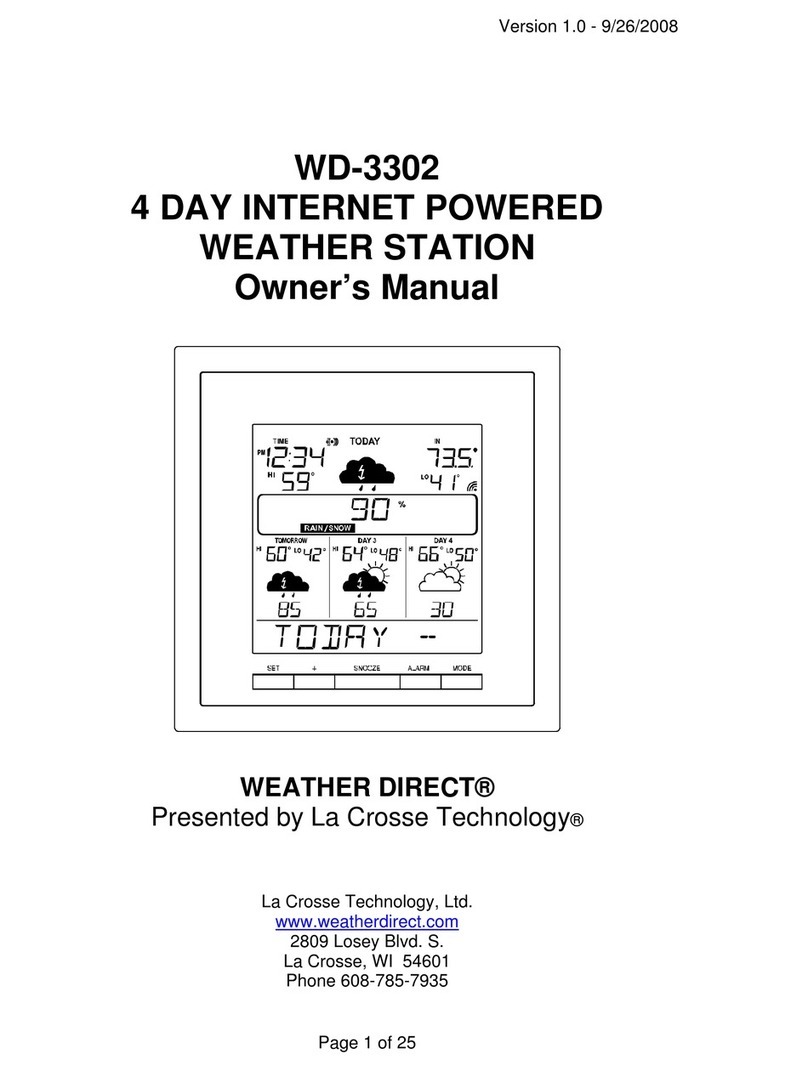
WEATHER DIRECT
WEATHER DIRECT Weather Direct WD-3302 owner's manual
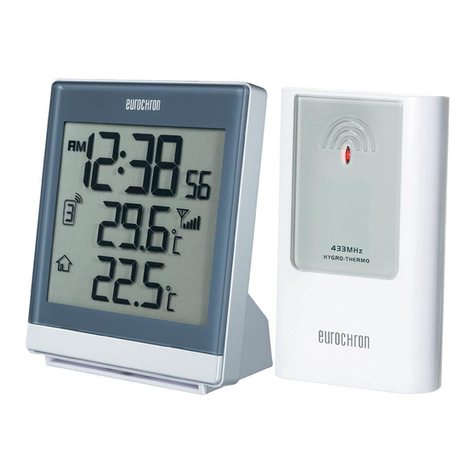
Eurochron
Eurochron EFWS 400 operating instructions
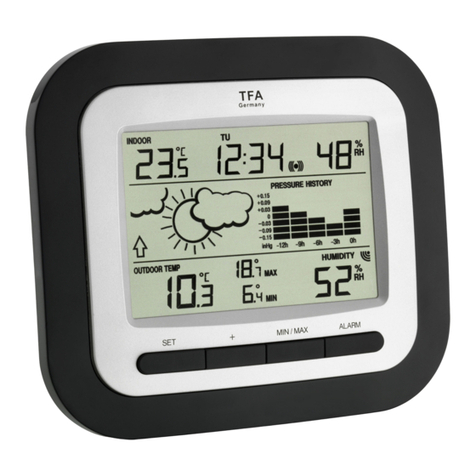
TFA
TFA 35.1113.IT instruction manual
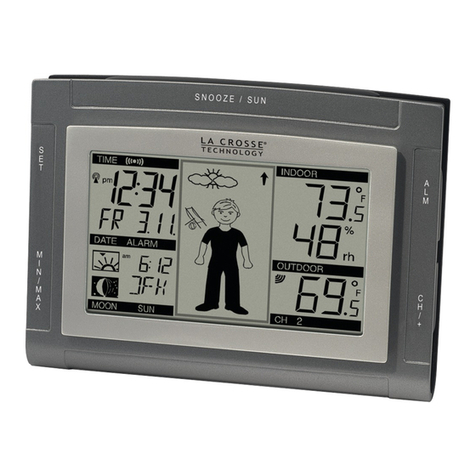
La Crosse Technology
La Crosse Technology WS-9611U-IT Quick setup instructions
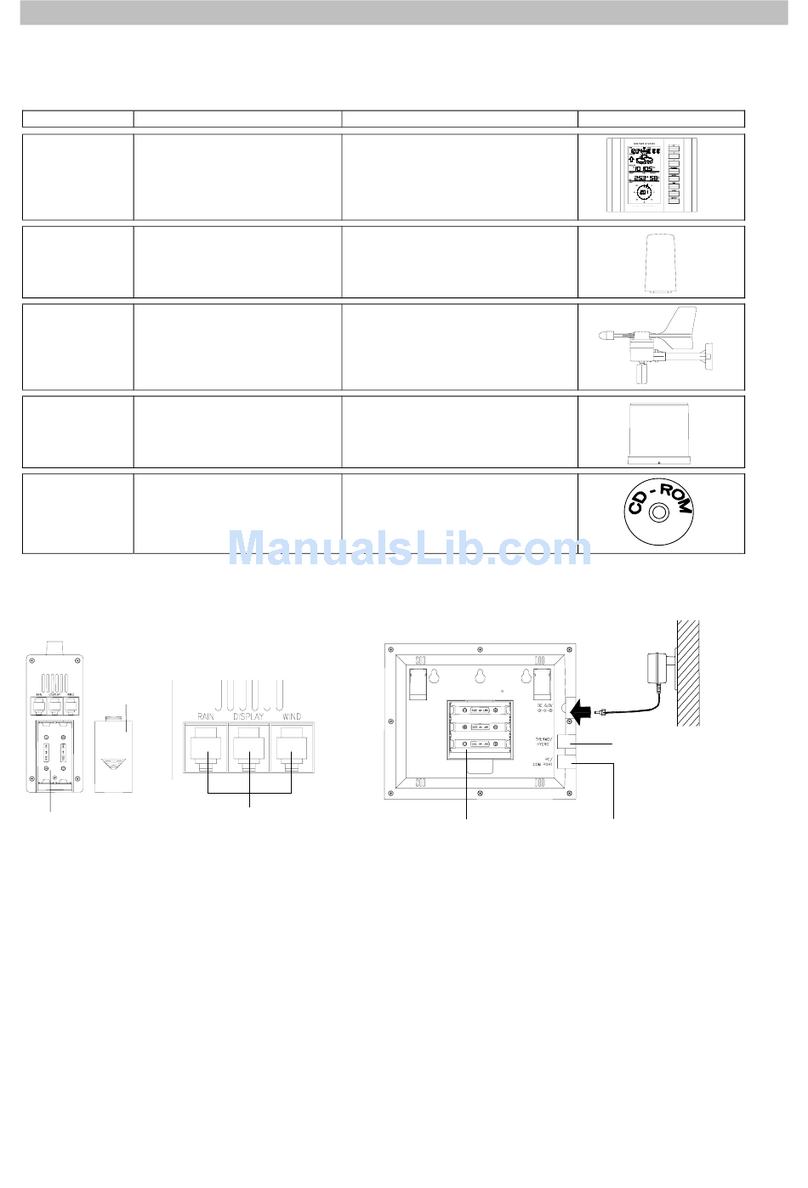
La Crosse Technology
La Crosse Technology WS-2310TWC Quick setup manual
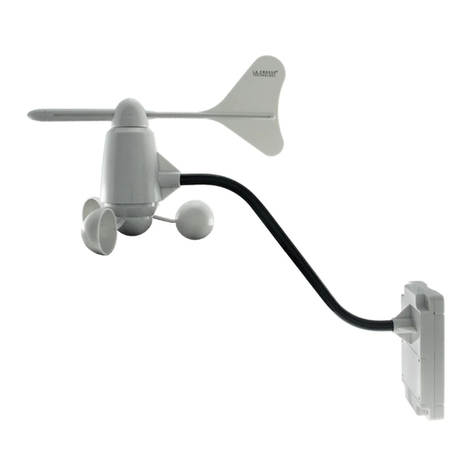
Honeywell
Honeywell TS805 Product brochure

La Crosse Technology
La Crosse Technology The Weather Channel WS-8500TWC-IT instruction manual

La Crosse
La Crosse 308-1451 instruction manual
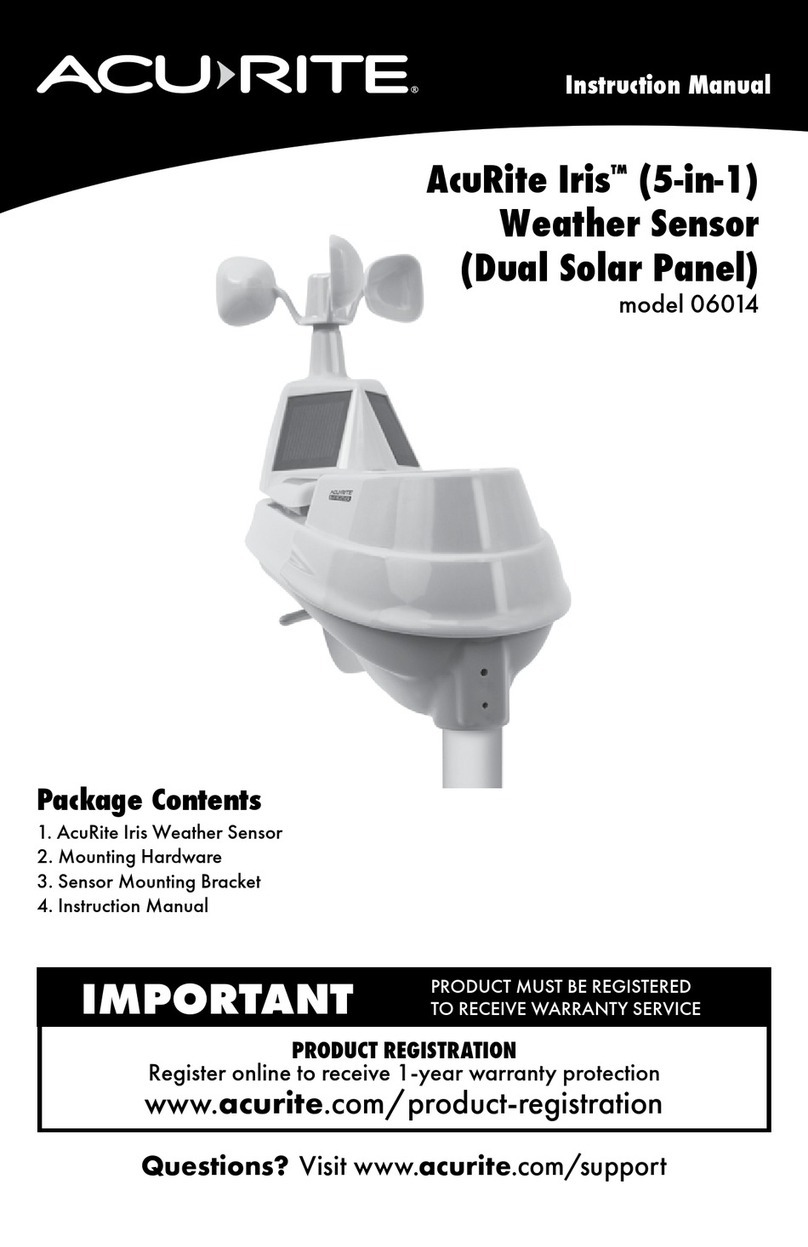
ACU-RITE
ACU-RITE Iris 06014 instruction manual
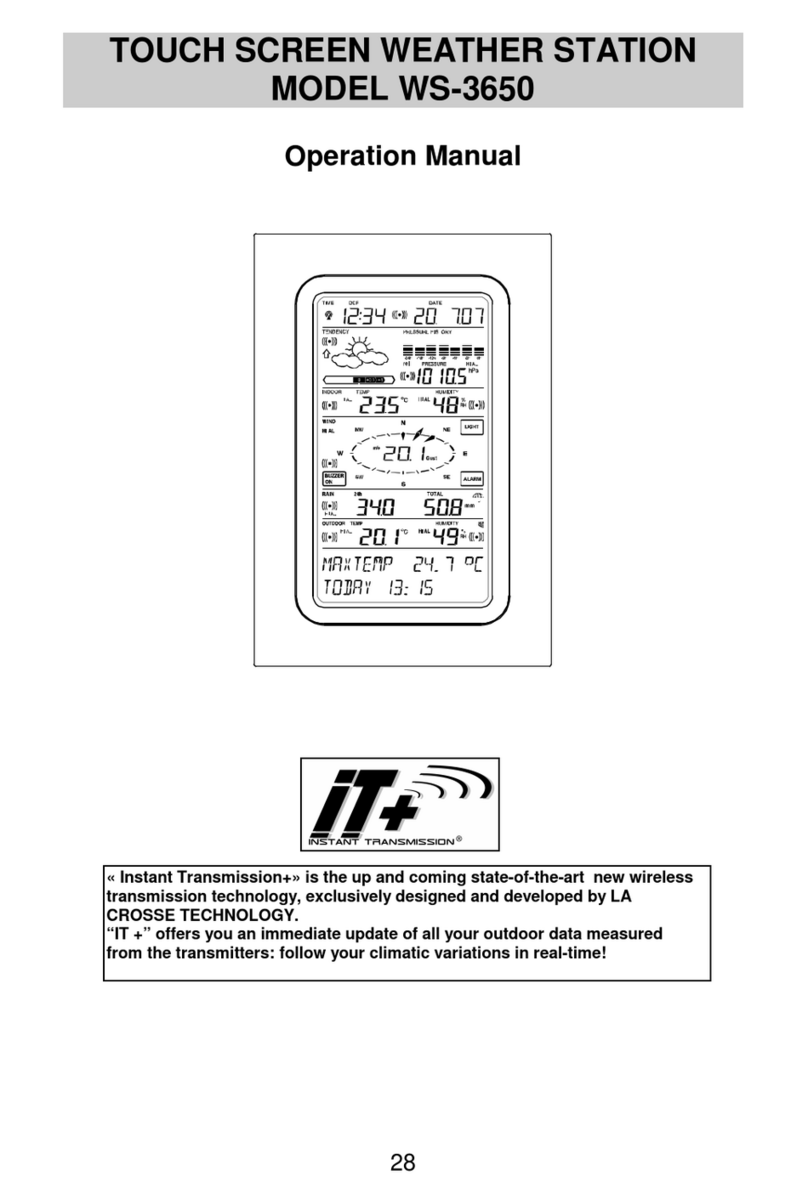
La Crosse
La Crosse WS-3650 Operation manual
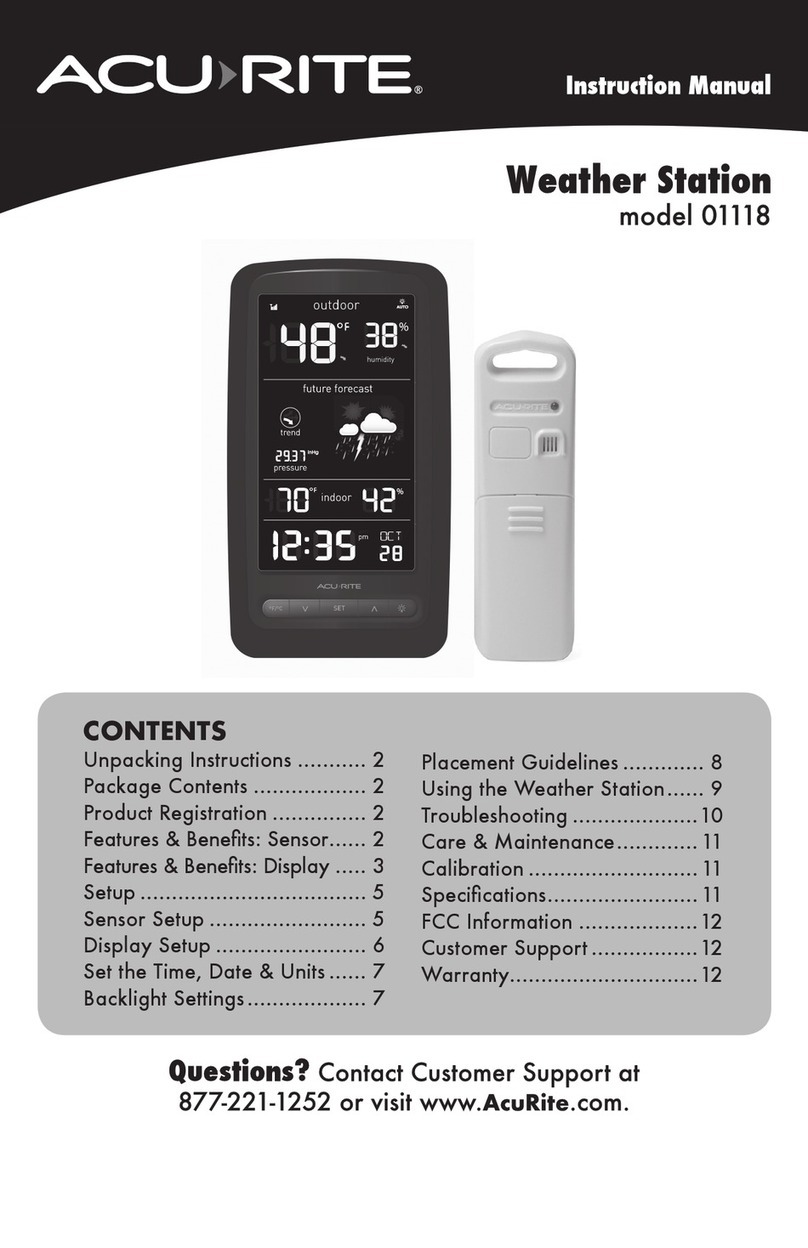
ACU-RITE
ACU-RITE 01118 instruction manual
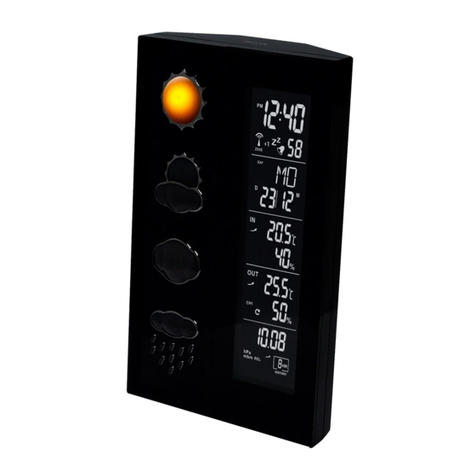
Technoline
Technoline WS6650 instruction manual
